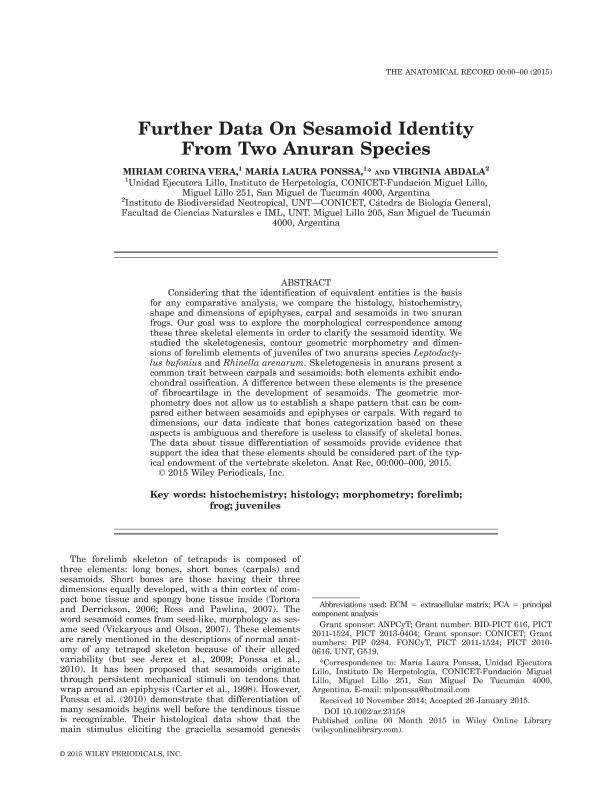Artículo
Further data on sesamoid identity from two Anuran species
Fecha de publicación:
08/2015
Editorial:
Wiley
Revista:
Anatomical Record-advances In Integrative Anatomy And Evolutionary Biology
ISSN:
1932-8486
Idioma:
Inglés
Tipo de recurso:
Artículo publicado
Clasificación temática:
Resumen
Considering that the identification of equivalent entities is the basis for any comparative analysis, we compare the histology, histochemistry, shape and dimensions of epiphyses, carpal and sesamoids in two anuran frogs. Our goal was to explore the morphological correspondence among these three skeletal elements in order to clarify the sesamoid identity. We studied the skeletogenesis, contour geometric morphometry and dimensions of forelimb elements of juveniles of two anurans species Leptodactylus bufonius and Rhinella arenarum. Skeletogenesis in anurans present a common trait between carpals and sesamoids: both elements exhibit endochondral ossification. A difference between these elements is the presence of fibrocartilage in the development of sesamoids. The geometric morphometry does not allow us to establish a shape pattern that can be compared either between sesamoids and epiphyses or carpals. With regard to dimensions, our data indicate that bones categorization based on these aspects is ambiguous and therefore is useless to classify of skeletal bones. The data about tissue differentiation of sesamoids provide evidence that support the idea that these elements should be considered part of the typical endowment of the vertebrate skeleton.
Palabras clave:
Histochemistry
,
Histology
,
Morphometry
,
Forelimb
,
Frog
,
Juveniles
Archivos asociados
Licencia
Identificadores
Colecciones
Articulos(CCT - NOA SUR)
Articulos de CTRO.CIENTIFICO TECNOL.CONICET - NOA SUR
Articulos de CTRO.CIENTIFICO TECNOL.CONICET - NOA SUR
Citación
Vera, Miriam Corina; Ponssa, María Laura; Abdala, Virginia Sara Luz; Further data on sesamoid identity from two Anuran species; Wiley; Anatomical Record-advances In Integrative Anatomy And Evolutionary Biology; 298; 8; 8-2015; 1376–1394
Compartir
Altmétricas




